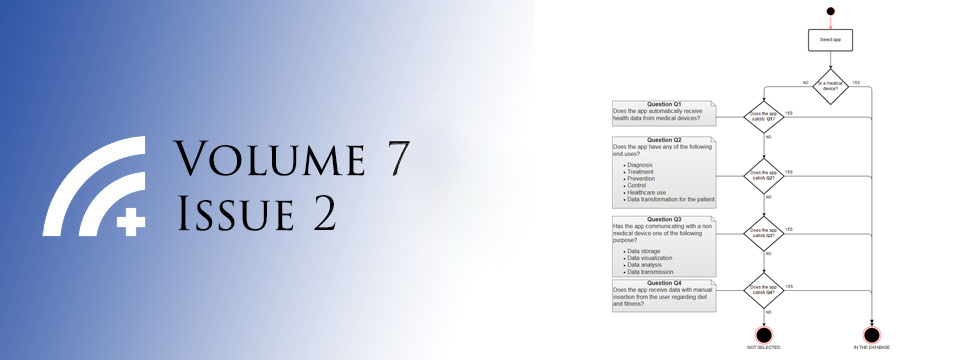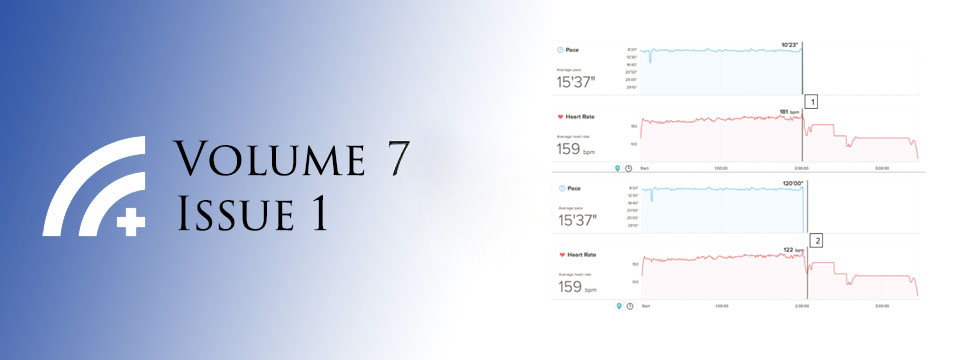Posted on Mar 1, 2012 in News |

The Editorial Board at the Journal of Mobile Technology in Medicine is proud to present our inaugural publication, Volume 1, Issue 1, published on March 1st 2012. After our initial announcements in November 2011, we have had considerable interest from researchers in the field, and received a number of submissions. Mobile technology in Medicine is a rapidly developing area, and we hope that with the official launch of our journal, we will help accelerate research in the field.
Volume 1, Issue 1 Contents
Editorials
001 The Evolution of E-Health – Mobile Technology and mHealth
C. Perera
003 The Need for an Evidence-Base in Mobile Technology in Medicine
R. Chakrabarti
005 The (Ultra)sound of Things to Come
C. Cabalag
Original Articles
008 The Reliability of Mobile Multimedia Messaging (MMS) for Decision Making in Distal Radius Fractures: An Effective Alternative
G. Padmasekara
013 Orthopaedic Surgical Technique Guides: Are They Readily Available in an Electronic Format?
N. Nazarian
016 Use of a Smartphone for Monitoring Dermatological Lesions Compared to Clinical Photography
R. Asaid
019 Qualitative Study on the Applications of Smartphones in Medical Research
L. Abeynaike
Case Reports
024 Use of a Tablet to Enhance Standardisation Procedures in a Randomised Trial
M. Parker
In keeping with our open-access principles, all articles are published both as full text and as PDF files for download. For your convenience, attached to this post is a PDF file containing the complete Volume 1, Issue 1, which can be easily downloaded and saved for viewing offline.
We look forward to hearing from readers in the comments section, and encourage authors to submit research to be considered for publication in this peer-reviewed medical journal.
Yours Sincerely,
Editorial Board
Journal of Mobile Technology in Medicine
Posted on Mar 1, 2012 in Articles, Editorial |
Dr Chandrashan Perera MBBS1,2
1Editor-In-Chief, Journal of Mobile Technology in Medicine, 2Austin Hospital, Melbourne, Australia
Corresponding Author: editor@journalmtm.com
Journal MTM 1:1:1-2, 2012
http://dx.doi.org/10.7309/jmtm.1
Medicine has always been an information intensive field from the first days of practice, when pearls of wisdom were passed along the generations as word of mouth. Throughout history, informatics has been an integral part of medicine, facilitating the storage and accession of vast amounts of data. This has come to the culmination of present day medical practice, which is built on the foundations of Electronic-Health (E-Health). New information is rapidly disseminated through electronic access to medical journals and other relevant sources of information. Patient data is increasingly stored electronically, and reference information including textbooks are stored electronically in websites. The E-Health revolution digitized the world, and medicine has benefited immensely. Whilst having this information available electronically has numerous benefits, the delivery of this information to medical staff has been less than ideal, requiring doctors to be tied down to devices such as immobile desktop computers. The next stage in digital informatics is to gain rapid access in both storing and creating material in a convenient manner; and smartphones have been an instrumental tool in this evolution.
Posted on Mar 1, 2012 in Articles, Editorial |
Dr Rahul Chakrabarti MBBS1,2
1`Editor-In-Chief, Journal of Mobile Technology in Medicine, 2Royal Eye & Ear Hospital, Australia
Corresponding Author: rahul@journalmtm.com
Journal MTM 1:1:3-4, 2012
http://dx.doi.org/10.7309/jmtm.2
Modern medical practice is undergoing a transformation in the way it communicates and provides healthcare. The evolution in medicine has been advanced by the human desire to provide and receive a high standard of affordable medical care within an appropriate time. A significant contribution to this has been facilitated by advances in modern technology and telemedicine. Whilst a tsunami of easily accessible technology has engaged the attention of the medical community and improved access to medical care, particularly in remote areas, there is always an element of concern regarding safety, reliability, reproducibility and accuracy of telemedicine methods.
Posted on Mar 1, 2012 in Articles, Editorial |
Dr Carlos Cabalag MBBS1,2
1Editor, Journal of Mobile Technology in Medicine, 2Monash Medical Centre, Melbourne, Australia
Corresponding Author: carlos@journalmtm.com
Journal MTM 1:1:5-7, 2012
http://dx.doi.org/10.7309/jmtm.3
The use of mobile technology in medicine is not limited to the tablet computer or the use of the ever-popular Apple® iPhone. As semi-conductors become smaller, various devices are being redeveloped and transformed into portable miniature versions of their old previously large and cumbersome counterparts. In particular, we have seen the advancement and miniaturisation of piezoelectric transducers in the recent decade, leading to the development of portable ultrasound machines that can be utilised virtually anywhere and in settings of dire need. The most tragic and recent of those events was the Haitian earthquake in 2010, where 230,000 people lost their lives with many more injured in a background of crucial infrastructural destruction that was seemingly endless to the naked eye.1RCA. Haiti Earthquake Appeal, 2010. http://www.redcross.org.au/haiti-earthquake-appeal-2010.aspx: Red Cross Australia, 2010. Notably, one of the devices that had shaped the humanitarian effort to save lives, was (and still is) the humble portable ultrasound. (Refer to Figure 1). Are clinicians ready for the next diagnostic tool, some branding it as the next ‘pocket stethoscope’?
Posted on Mar 1, 2012 in Articles, Original Article |
Dr Gayan Padmasekara MBBS1, Dr Navid Nazarian MBBS1, Dr Christopher Wall MBBS1
1Department of Orthopaedics, Southern Health, Melbourne, Australia
Corresponding Author: gayan@padmasekara.com
Journal MTM 1:1:8-12, 2012
http://dx.doi.org/10.7309/jmtm.4
Background: Assessment of radiology is an integral part of fracture management in orthopaedic surgery. Mobile multimedia messaging (MMS) can be utilised in the referral process of patients with fractures. However, the reliability of using MMS in making management decisions in distal radius fractures has not been assessed.
Methods:Radiographs of 20 consecutive cases of distal radius fractures managed with closed reduction and plaster, and 20 cases managed with open reduction and internal fixation (ORIF) were analysed retrospectively by two blinded orthopaedic surgeons on a computer and anApple iPhone 3GS. The inter- and intra-rater agreements were assessed.
Results: Inter-rater agreement between the MMS group and the picture archiving and communication system (PACS) group were consistent among the surgeons (K -0.55, 0.80, p<0.001). However, the management decisions were different in seven cases (8.75%) in the study group.
Conclusion: MMS x-ray pictures can be useful in formulating management plans for patients with distal radius fractures. With advancing technology smartphones will likely play a larger role in the communication process in delivering orthopaedic care.
Posted on Mar 1, 2012 in Articles, Original Article |
Dr Navid Nazarian MBBS1, Dr Christopher J Wall MBBS 1, Dr Gayan Padmasekara MBBS 1
1Department of Orthopaedics, Southern Health, Melbourne, Australia
Corresponding Author: nanazarian@yahoo.com
Journal MTM 1:1:13-15, 2012
http://dx.doi.org/10.7309/jmtm.5
Background: New developments in mobile technology have had a profound effect on medical care worldwide.1 In orthopaedic surgery a variety of implants and devices are used, and knowledge about their designs, specific features and surgical techniques is essential. The purpose of this study was to assess whether orthopaedic surgical technique guides are readily available in an electronic format.
Methods: A list of thirty-two orthopaedic device companies currently trading in Australia was generated through a structured internet search and by reviewing a tertiary hospital database. The Apple store was searched for iPhone or iPad surgical technique applications for each company. Company websites were searched for downloadable surgical technique guides. Companies without downloadable surgical technique guides or iPhone applications were contacted via email or telephone to ask whether such products were in development.
Results: Of the thirty-two orthopaedic device companies studied, twenty-two (68.8%) had surgical technique guides available for download on their websites. Four (12.5%) companies had an iPhone or iPad application available in the Apple store.
Conclusion: Although many orthopaedic device companies have downloadable surgical technique guides on their websites, only a few had iPhone or iPad applications for their products. Further development of such products may be beneficial for orthopaedic surgeons.










